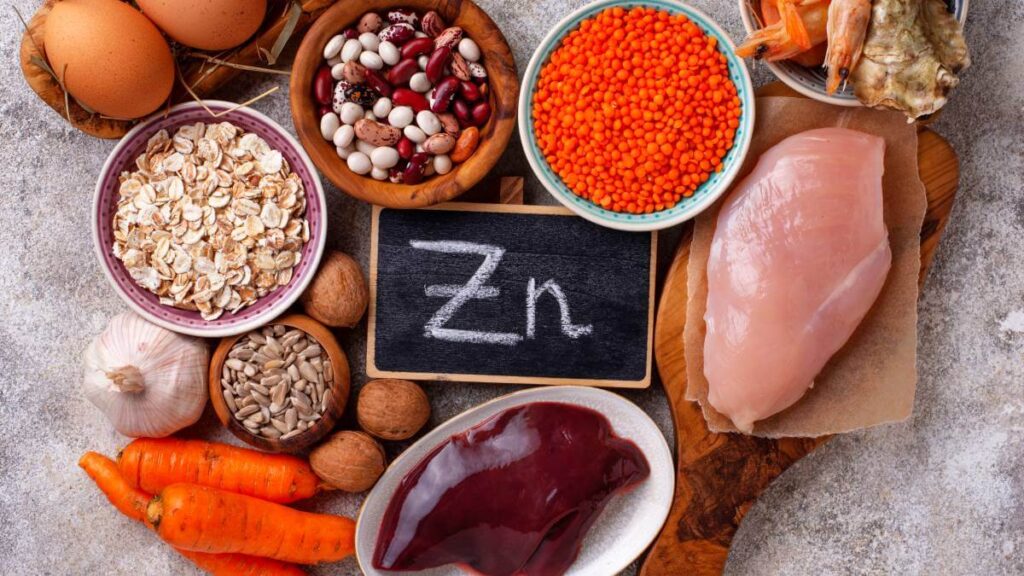Zinc plays a vital role in overall health and function. It aids our sense of taste and smell and helps wounds heal efficiently. It bolsters your immune system and much more.
Zinc activates the enzymes that break down proteins in viruses and bacteria. So a deficiency can mean you’re susceptible to infection and associated symptoms.
While there’s no research to suggest zinc supplements can prevent coronavirus – or any other supplement for that matter – ensuring all our nutritional needs are met, primarily through a varied healthy diet, is vital for strong immune function.
How much zinc do we need?
Dr Sarah Brewer explains that the recommended intake for zinc is 10mg per day (although the National Institutes of Health puts daily guidelines at 11mg a day for men aged 19 to 64 and 8mg a day for women), but says many of us don’t realise we aren’t getting enough.
Dr Brewer notes that while we tend to pay a lot of attention to vitamins, minerals are equally important – although we might often be less aware of them.
Getting enough zinc is important. But it’s also vital not to take too much. Zinc levels can build up in your system potentially resulting in serious side-effects.
You shouldn’t take more than 25mg of zinc supplements a day, unless advised to do so by a doctor.
How can I get zinc in my diet?
“Most adults obtain sufficient amounts of zinc in their diet from eating a wide range of different foods, each containing moderate amounts of zinc, rather than from a few foods containing high levels of zinc,” says Anne de la Hunty, a scientist and nutritionist.
With that in mind, Ms de la Hunty explains which foods contain zinc.
1. Meat
“As well as being a good source of protein and iron, red meat is a good source of zinc; it typically accounts for a third of all zinc in the diet. What’s more, the zinc in meat is readily absorbed,” says Ms de la Hunty.
“Stewed, extra-lean, mince provides around 59 per cent of the RNI (Reference Nutrient Intake) for an adult man and 80 per cent of the RNI for a woman. Other great sources include grilled lamb chops, which provide around 3.6mg for every 100g.
“I advise you to choose lean cuts of meat and cut off any fat before cooking to reduce the amount of saturated fat,” she adds. “However, too much red and processed meat can increase the risk of some cancers. For this reason, many health experts recommend that, on average, we should eat no more than 70g of red and processed meat a day, or 490g a week.”
2. Fish and shellfish
“Fish, such as tuna and salmon, and shellfish provide around 3 per cent of the zinc in the average diet. Both crab and prawns are a good source of well-absorbed zinc. However, it’s always important to make sure the shellfish is well cooked, especially if you’re pregnant, to reduce the risk of food poisoning,” she says.
“Health experts also recommend we should consume oily fish, such as salmon, mackerel and sardines, once a week. A 140g portion of sardines, for instance, would provide around 46 per cent of the RNI for an adult woman.”
3. Nuts and seeds
“Pine nuts and roasted cashew nuts are really high in zinc (6.5mg for every 100g and 5.7mg for every 100g respectively) and also contain high amounts of protein and unsaturated fats, which are important components of a balanced diet,” says Ms de la Hunty. “A small handful of roasted cashew nuts make a good zinc-boosting snack.
“Look out for seeds and tahini paste, made from sesame seeds, too, especially if you’re looking for alternative zinc sources to meat. Toasted seeds, sprinkled on salads, add flavour and crunch, as well as zinc, to your salad. Nuts and seeds are, however, high in calories and so should not be eaten in large quantities as snacks.”
4. Milk and cheese
“A pint of semi-skimmed milk, with breakfast cereal and in tea and coffee over the day, can provide around 2.3mg of zinc to the average adult. Cheddar cheese is also a good source of zinc, as well as providing protein, calcium and iodine.
“Cereal products can also bulk up your numbers. Although most cereals do not contain high levels of zinc, they are an important source in the diet because they’re eaten in large quantities.”
5. Legumes
“Legumes, such as peas, beans and lentils contain zinc, although not in very high amounts either. Plus, they also contain phytates, which reduce the overall amount of the mineral absorbed by the body,” says Ms de la Hunty.
“Nevertheless, when consumed in larger amounts, as the main protein source in a meal, they can make a significant contribution to our intake. For example, a 200g portion of reduced sugar baked beans would provide 10 per cent of the RNI for an adult man.
“A good serving of peanut butter, hummus made from chickpeas and tahini paste, and fried tofu are also good sources for vegans.
“Beans, peas and lentils are good alternatives to meat because they’re low in fat and high in fibre, protein, vitamins and minerals. Add them to soups, stews and ragùs to make your meal go further,” she suggests.
“And an extra tip? Soaking dried beans overnight before cooking them can deactivate the phytate and increase the amount of zinc that is absorbed.”
Do you pay attention to your diet to ensure you’re getting sufficient vitamins and minerals? Do you take any supplements? Let us know in the comments section below.
Also read: Telltale signs you have a magnesium deficiency
– With PA

